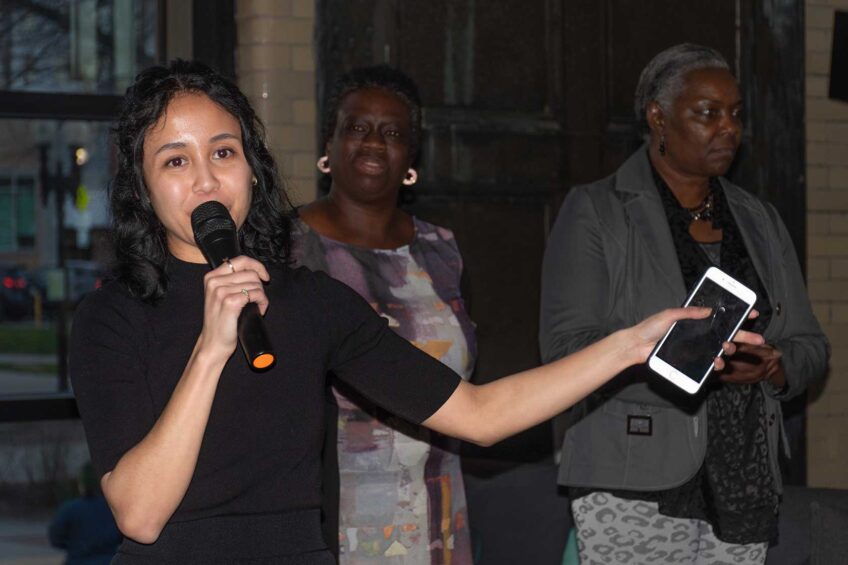How rising homelessness strikes Boston’s students
City councilors, schools look to tackle growing crisis

Neema Avashia, grade 8 civics teacher at John W. McCormack Middle School, had a problem. It was the third month of the 2014 school year and she had a student who continued to fall asleep nearly every class. Had it been early in her teaching career, Avashia might have worried her class was boring. But by then it was her 12th year of teaching and she knew something was up.
The student, Avashia found out, was living out of a car. Since losing their home, the student’s family slept in their car most nights. The girl did not always have somewhere to brush her teeth or wash her clothes, let alone a quiet place to do homework.
She was just one of many Boston students living without a stable living place. This year Avashia has four eighth graders without permanent housing, including a 14-year-old boy forced to live in the same room as his mother — something that obviously raises tensions in the relationship.
Across Boston Public Schools this year, 2,363 children— about 4 percent — are homeless, according to numbers reported in July by the Boston Herald. BPS’s Homeless Education Research Network estimates the number is closer to 3,000.
As they enter their new term, City Councilors Tito Jackson and Annissa Essaibi-George have said that homeless students are high on the agenda.
By the numbers
4-5 percent of Boston Public School students are homeless, depending on counts
35 percent or more increase in homeless children, youth and young adults in Boston between 2014-2015
25 percent increase in homeless families in Boston between 2014-2015
School change chaos
The disorientation and stress of living without a stable place to call home can be traumatic to children and adults alike. Many times it can lead to losing one’s original school as well — another disruption that is the last thing these children need, Jackson and Essaibi-George said.
“School for many children is the one constant in their lives,” Essaibi-George said. “When things happen that disrupt the regular rhythm and practice of their daily lives, school can remain that one constant.” Should children have to transfer, new schools become “another point of chaos and change.”
The city is required to provide transportation for students housed in far-away shelters so that they may remain enrolled at their school, but the longer transit times may prove too difficult for the family.
“I‘ve been told anecdotally that there are children that are traveling an hour-and-a-half to two hours to school,” Jackson said. “That’s very difficult, in particular for young children.”
This instability affects academic success, according to information posted on Homeless Education Research Network’s website.
“Every time a child has to change schools, his or her education is disrupted,” HERN reports. “According to some estimates, three to six months of education are lost with every move. Some students may have to repeat a grade.”
Instability on all levels
Homelessness introduces instability on all levels of life, from forcing people to leave their community entirely — as they go to shelters and transfer to new schools — to disrupting daily minutiae. Showering and laundry become challenges for families living in a car.
Students find it difficult to focus on lessons and keep their materials organized when basic hygiene, nutrition and stability needs go unmet. Simple educational tasks like keeping school supplies and uniforms organized can be a hard for homeless students who may have to carry all their belongings with them and do not know where they will be sleeping each night.
“How do you have good organization when you’re carrying all your things everywhere?” Avashia said.
And the effects of restoring stability can be dramatic. When Avashia’s student finally secured a place to call home, her failing grades turned to As and Bs, she no longer seemed depressed and her sense of humor emerged.
Common procedure
Schools need more resources and guidance for approaching homelessness, Avashia said. And some of that can be simple: giving teachers a clear outline of steps or possible approaches to pursue in these kinds of situations, along with lists of who can be contacted.
Through collaboration with social workers and discussions, the McCormack Middle School organized an approach to help its students. A school-based committee identified several teachers as resources students could approach to meet basic needs, such as breakfast or a toothbrush. The McCormack committee raised money to let the family stay in a hotel some nights. When these funds ran out, the guidance counselor talked the student through coping plans to prepare her for staying in her car or for yet another move. The counselor attended Department of Transitional Assistance meetings with the family.
Despite these separate initiatives, schools’ response systems are haphazard. They depend on individual teachers and staff noticing issues and resolving them as best as they can, Avashia said.
“We’re all just fumbling and doing the best we can,” she said.
Had she just entered teaching, she might have been too caught up figuring out how to be a good educator to realize what a student sleeping in class might signify, Avashia added.
“These actions aren’t things you learn in teacher preparation. No one tells you what to do if you have a student sleeping in their car.”
As instances like these become a daily fact of life for many schools, teachers need training in handling and identifying issues related to homeless and other traumas.
On the web
HERN facts and figures: http://bostonhern.org/about/facts/#content
Boston Public Health Commission 2014-2015 homeless census: http://www.bphc.org/healthdata/otherreports/Documents/2015_HomelessCensusKeyFindings.pdf
Meeting basic needs
Another remedial option: organizing schools to satisfy their children’s basic survival needs on site.
Schools need a washing machine and a dryer for kids who do not have access to laundry, Avashia said, and private showers — not the open locker room variety — for children to clean themselves up. Food pantries or food bank pick-ups could be located at the school. Another help: systems to provide warm clothes and school supplies for those in needs.
When Avashia’s school previously had a snack program, children would take extra food on Thursdays and Fridays to stock up for the weekend, when they were less sure they would be able to eat. While McCormack provides breakfast and lunch, school vacations and weekends can be bleak for children who do not know where their next meal will come from.
“[Children] can feel really nervous about where they’re going to get food on the weekend,” she said.
Greater staff would help as well. While McCormack’s guidance counselor was able to make great strides with the student, some schools have only one counselor for hundreds of students.
A city matter
City councilors are preparing to examine the problem of student homelessness.
Essaibi-George said she sees a need for schools to become warning systems that can identify at-risk families and connect them with services to help them avoid homelessness. She also envisioned schools offering more wraparound support services for both students and their families.
Jackson said he intends to convene a city council hearing to explore how different organizations and individuals who work with homelessness and housing can collaborate with BPS to provide resources to students.
Rising numbers of homeless students reflect a wider issue affecting Bostonians of all ages. As Boston’s housing crisis continues, more people become homeless. The number of affected families increased by 25 percent from 2014 to 2015, according to the latest Boston Public Health Commission homeless census.
“As an overarching goal, the city needs to be able to create more housing,” Essaibi-George said. “That’s a goal of the city that we need to continue working towards.”

![Banner [Virtual] Art Gallery](https://baystatebanner.com/wp-content/uploads/2024/05/Breathe-Life-4-ToGetHe_WM-150x150.jpg)




